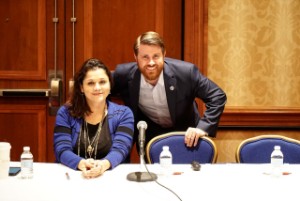
When thinking of strategic enrollment and high potential groups to target, low income and minority groups is what generally comes to mind. However, what about the concept of student veterans? With America currently in the longest ongoing war in our country’s history, veterans are rapidly filling the demographic landscape. Almost half of post 9/11 veterans are commonly 18-34 years old, making up about 20% of overall American veterans. About 55% of this group make movement towards higher educational attainment after being discharged. The reality is that institutions have opportunities to heighten their enrollment by targeting these veterans. Why is it that they don’t capitalize on this chance?
Gaps in life experience
Jared Lyon, President of Student Veterans of America, asked this same question as he opened his engaging session "Student Veterans: A Valuable Asset to Higher Education" at
2018 AACRAO SEM.
A Navy veteran himself, Lyon enrolled in college at 28 years old, after completing his military duty. A first generation college student, he was excited with the potential job opportunities that higher education could afford him. However, he felt gaps in life experience with his peers, and found difficult to identify with the campus culture. After only two weeks of college Lyon was ready to drop out--until he discovered resources specifically targeted towards student veterans.
One he located these community building and integration avenues for student veterans, Lyon stayed and successfully completed his degree. But it begged the question--do all colleges have these resources to help student veterans? What can institution officials do to discourage this sense of loneliness and alienation? And why are student veterans so disregarded in the grand scheme of things?
Public perception of veteran intelligence
The history of disregard for the military members' intelligence can be traced back to the origins of the G.I. Bill in 1944. When the bill was introduced, covering college tuition for military and guaranteeing a spike in student veterans, numerous institutions argued against it, citing a denigration in the quality of campus life. Harvard President James B. Conant was a fierce opponent, and much of the public shared his sentiments--veterans had only entered the military as they weren’t “smart” enough to receive degrees, so why should they be admitted into colleges after their service ended? Today, around 53% of employers think that veterans don’t do well post military--and many veterans share that same sentiment. If even veterans think so lowly of their academic capabilities, the responsibility lies with the institution to ensure that they are providing ample resources to facilitate the way to higher education.
The reality of veteran students
The reality is that veteran students consistently outperform their peers in the academic realm. Veteran students are found to have an average 3.34 GPA when compared to their peers, who average 2.94. Veterans who receive degrees go on to become successful members of the government, STEM fields, and humanities. On top of that, minority veterans earn degrees at higher rates than their white counterparts--3.18% higher, enriching our professional landscape. This academic performance isn’t the only reason academic institutions should appeal to veterans.
Enrichment of institution culture comes along with student veterans, as they bring their experiences into the fold--of being older, married, disabled, or first generation college attendees. Financially, the G.I. Bill has pumped over $75 billion dollars into higher education since 2017.
Appeal to veterans
Every year, 115,000 veterans begin their higher education path. Many individuals in society have the perception that people join the military to pay for college. So why is there so little attention or resources for student veterans? Appeal to the current generation of student veterans through social media, marketing and just having accessibility for campus resources. Make them feel included, and find your campus better for it.